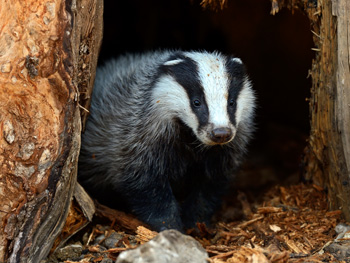Badgers and Badger Setts
Badgers are territorial animals who live in social groups called ‘clans’. The territory of these clans can vary in size from 0.2km2 to 1.5 km2 with anywhere between two and twenty badgers present. In areas where two clans meet territorial boundaries become well-defined, marked by a series of dung pits called latrines. In areas with relatively low badger populations there will be less competition for territory and the number of territorial markings will be low or even non-existent.
Badgers use paths around their territory repeatedly, following a scent trail from previous use; thus, badger paths become well worn. These paths are important to the badgers and obstruction to these paths will interfere with the badger’s movement around their territory.
Badger setts are any structure or place which displays signs of current or seasonal use by a badger. Within a badger clan territory there can be several badger setts which are categorised in the following ways:
Main Sett. There will normally be one main sett in a territory. This will generally be the largest sett in the territory, typically with five or more entrances, will be permanently occupied throughout the year and used as the breeding sett.
Outlying Sett. These are the smallest setts with generally only one or two entrances. They are intermittently occupied and there can be any number in a territory.
Annex Sett. A sett of intermediate size, located close to the main sett and connected by well-defined paths. These are occupied for prolonged periods and may be used as a second breeding sett if there are two breeding sows in the clan.
Subsidiary Sett. A sett of intermediate size, similar to an annex sett but located at some distance from the main sett and not connected to the main sett by defined paths.
Badgers can mate at any time of year but delayed implantation controls the time of birth. Most cubs are born between January and March but they can be born at any time between December and June. An average of two to three badger cubs are born to each sow and will initially be totally dependent on their mother. Cubs do not appear above ground until during April or May when they are 8 – 10 weeks old and are not fully weaned until at least June of each year.
Badgers are omnivorous but their preferred food source is worms and insects. Worms are most abundant in well-grazed pastureland while mixed woodland is a good source of insects and grubs. Badgers have a soft and supple nose with which they snuffle into the ground to find insects. When they do this, they leave distinct round holes known as snuffle holes or grubbings. Badgers easily find worms on the surface of well-grazed pastureland and often leave no visible indications of this foraging.
Badgers are protected under Schedule 6 of the Wildlife and Countryside Act (1981) and the Protection of Badgers Act (1992).
This makes it an offence to take, kill or injure a badger, cruelly ill-treat a badger, use badger tongs or firearms in the killing or taking (or attempt) of a badger. It is also an offence to damage, destroy, obstruct access to, or any entrance of, a badger sett, to cause a dog to enter a badger sett or disturb a badger while it is occupying a sett.
